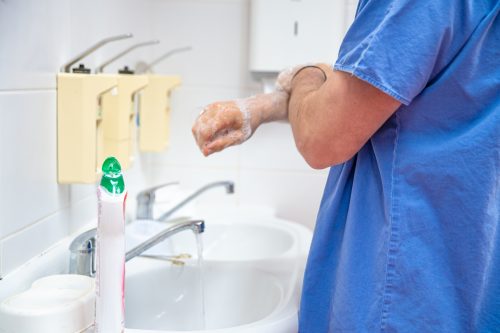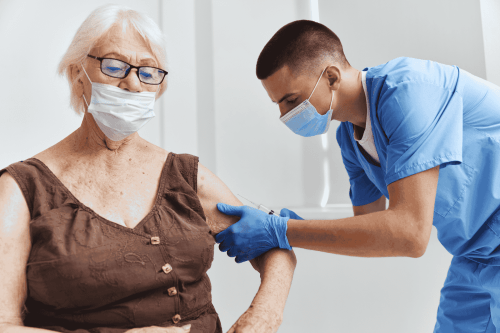More than a million hospitalized patients each year acquire healthcare-associated infections (HAIs) while being treated for other health conditions. Despite rigorous training and established protocols, mistakes in infection control can still occur, leading to severe consequences, including the spread of healthcare-associated infections (HAIs). In this blog, we will explore common infection control mistakes and provide practical tips on how to avoid them, helping to create a safer healthcare environment for everyone.
-
Inadequate Hand Hygiene

One of the most common and preventable mistakes in infection control is inadequate hand hygiene. For instance, healthcare providers often fail to wash their hands properly or frequently enough, leading to the transmission of pathogens.
To avoid this mistake, healthcare facilities should enforce strict hand hygiene protocols. Providers should wash their hands with soap and water for at least 20 seconds or use an alcohol-based hand sanitizer before and after patient contact, after touching potentially contaminated surfaces, and after removing gloves. Furthermore, regular training and reminders can reinforce the importance of hand hygiene.
-
Improper Use of Personal Protective Equipment (PPE)
Common infection control mistakes include wearing the wrong type of PPE for the task, reusing disposable PPE, and not removing PPE correctly. Improper use of PPE, such as masks, gloves, and gowns, can lead to contamination and the spread of infections. Therefore, healthcare facilities should provide comprehensive training on the correct use of PPE. Staff should be educated on selecting the appropriate PPE for different procedures, the importance of using disposable PPE only once, and the proper techniques for donning and doffing PPE to prevent self-contamination.
Ensuring your team is well-equipped with the right knowledge and training is crucial. American Medical Compliance (AMC) offers premium, fully customized compliance training courses, designed to meet the specific needs of your organization. For teams of 100 employees or more, these courses are provided at no cost. By prioritizing tailored education, we can fortify your organization’s compliance, reduce risk, and assure unparalleled patient care.
-
Failure to Follow Sterilization and Disinfection Protocols
Inadequate sterilization and disinfection of medical equipment and surfaces can result in the persistence of infectious agents. Common infection control mistakes related to these are using incorrect disinfectants, insufficient contact time, and neglecting to clean all surfaces thoroughly.
To prevent these errors, healthcare facilities should implement standardized protocols for sterilization and disinfection. Therefore, staff should be trained on the correct disinfectants to use for various pathogens, the required contact time for effectiveness, and the importance of cleaning all surfaces, including less obvious areas. Routine checks and maintenance of sterilization equipment are also crucial.
-
Improper Handling of Sharps
Mishandling sharps, such as needles and scalpels, can lead to needlestick injuries and the transmission of bloodborne pathogens. Moreover, common infection control mistakes related to these include recapping needles, improper disposal of sharps, and not using safety-engineered devices.
To avoid these mistakes, healthcare facilities should enforce strict sharps management protocols. Staff should be trained to never recap needles and to dispose of sharps immediately after use in designated sharps containers. Additionally, the use of safety-engineered devices, such as needleless systems and retractable needles, should be encouraged to minimize the risk of injury.
-
Neglecting Environmental Cleaning
Inadequate environmental cleaning can lead to the accumulation of pathogens on surfaces, increasing the risk of HAIs. Common infection control mistakes in environmental cleaning include neglecting high-touch surfaces, using incorrect cleaning agents, and insufficient cleaning frequency.
To mitigate this risk, healthcare facilities should establish rigorous environmental cleaning protocols. For instance, high-touch surfaces, such as doorknobs, bed rails, and light switches, should be cleaned frequently with appropriate disinfectants. Staff should receive regular training on effective cleaning techniques and the importance of thorough environmental cleaning.
-
Inadequate Isolation Practices
Failing to properly isolate patients with contagious infections can lead to the spread of pathogens within healthcare facilities. The common infection control mistakes here include not recognizing the need for isolation, improper use of isolation rooms, and inadequate signage.
Therefore, healthcare providers should be trained to recognize the need for isolation and to implement appropriate isolation measures promptly. Isolation rooms should be used correctly, with clear signage to inform staff and visitors of the necessary precautions. Regular drills and training sessions can help reinforce the importance of isolation practices.
-
Lack of Adherence to Respiratory Hygiene and Cough Etiquette

Poor respiratory hygiene and cough etiquette can facilitate the spread of respiratory infections. Common errors include not covering coughs and sneezes properly, and not providing masks or tissues for patients and visitors. As a solution, healthcare facilities should promote respiratory hygiene and cough etiquette among staff, patients, and visitors. This includes educating everyone to cover their mouth and nose with a tissue or elbow when coughing or sneezing, providing masks and tissues in waiting areas, and placing hand hygiene stations nearby. To constantly remind the healthcare team, there should also be signage and educational materials.
-
Insufficient Training and Education
A lack of continuous training and education on infection control practices can lead to complacency and errors. For instance, healthcare providers may forget protocols or fail to keep up with the latest guidelines. To address this issue, healthcare facilities should provide ongoing training and education on infection control. This includes regular workshops, seminars, and online courses to keep staff informed about the latest best practices and guidelines. Encouraging a culture of continuous learning and improvement can significantly enhance infection control efforts.
-
Inconsistent Monitoring and Feedback
Inconsistent monitoring and lack of feedback on infection control practices can result in unrecognized mistakes and non-compliance. Without proper oversight, even trained staff may deviate from protocols. Therefore, healthcare facilities should implement regular monitoring and feedback mechanisms. This includes conducting audits, observing practices, and providing constructive feedback to staff. Moreover, these data from monitoring can be used to identify areas for improvement and develop targeted interventions.
-
Failure to Report and Investigate Infections

Not reporting and investigating infections promptly can prevent the identification of infection control breaches and hinder corrective actions. This can lead to repeated mistakes and ongoing transmission of infections.
It is important to encourage healthcare providers to report any infections or breaches in infection control protocols immediately. Facilities should have a clear reporting system and a dedicated team to investigate and address reported issues. These infection data can help identify trends and prevent future occurrences.
Conclusion
Infection control is a vital component of patient safety and healthcare quality. By recognizing and addressing common infection control mistakes, healthcare facilities can significantly reduce the risk of HAIs and create a safer environment for patients and staff. Continuous education, strict adherence to protocols, and a culture of accountability are key to successful infection control. Together, we can work towards minimizing infection risks and improving overall healthcare outcomes.
To ensure you and your team are equipped with the best practices in infection control, enroll in our comprehensive online course today. Our Infection Control Training for Hospitals & Urgent Care Facilities provides in-depth knowledge and practical tips to help you avoid common mistakes and safeguard patient safety.
Access the course here.



